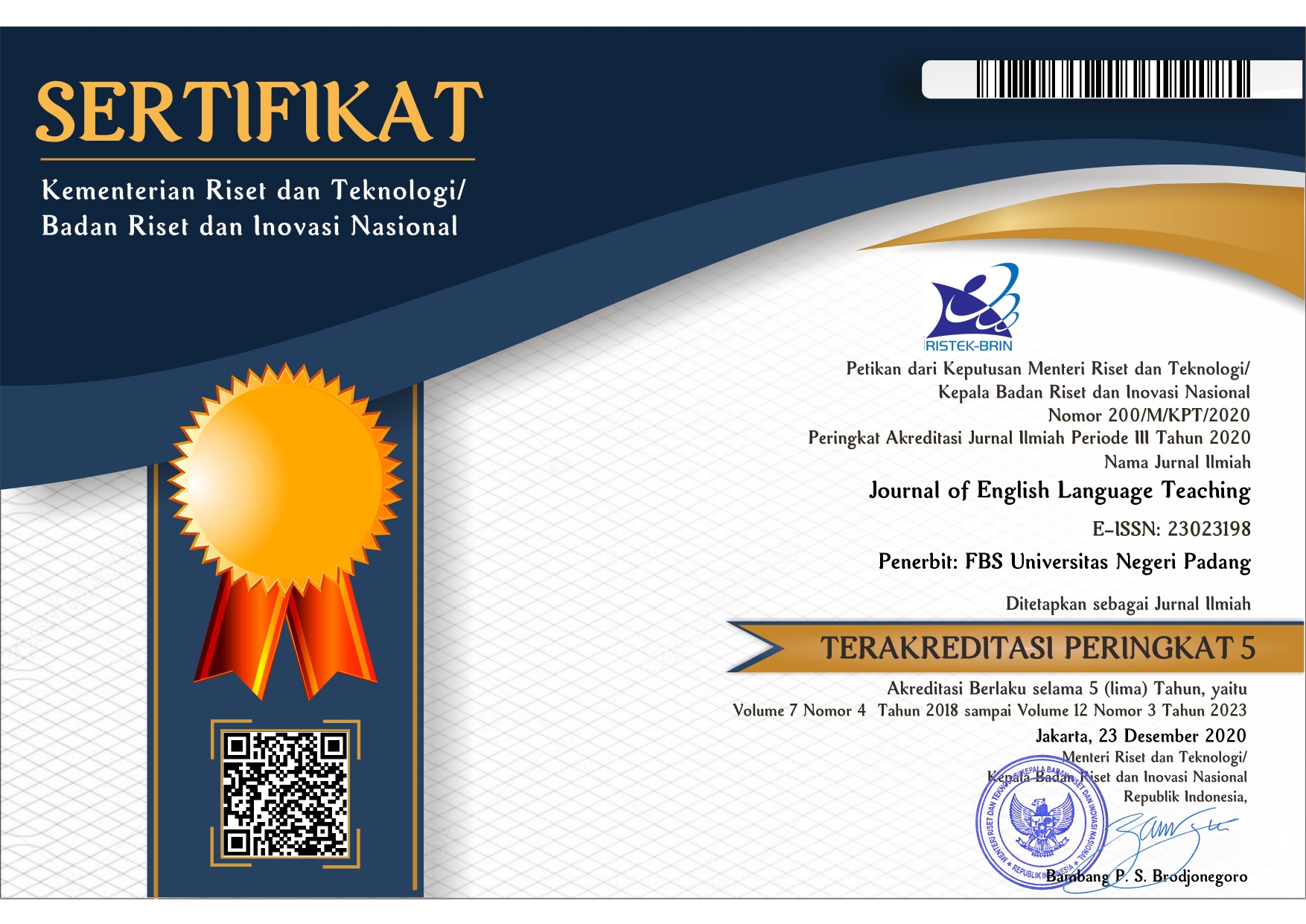CREATING INTERACTIVE WORD WALLS TO HELP ELEMENTARY SCHOOL STUDENTS’ VOCABULARY MASTERY
 ), An Fauzia Rozani Syafei(2),
), An Fauzia Rozani Syafei(2), (1) English Department Faculty of Languages and Arts State University of Padang
(2) English Department Faculty of Languages and Arts State University of Padang
 Corresponding Author
Corresponding Author
Copyright (c) 2017 Journal of English Language Teaching
DOI : https://doi.org/10.24036/jelt.v5i1.7343
Full Text:
 Language : en
Language : en
Abstract
The increasing of global communication makes the demand to mastering English also increase, including Indonesia. In learning English, understanding vocabulary is considered as an essential thing because without vocabulary, people will not be able to express their ideas and comprehend what other people say, in other words, they are not able to communicate each other. In order to mastering English vocabulary, students from elementary grade are introduced to English vocabulary by using many kinds of interactive media that can help this purpose. One of the media to help students’ vocabulary mastery is called Interactive Word Walls which is used in elementary school. Interactive Word Walls is a vocabulary learning media where the words that have been learned are displayed on the wall. This paper will discuss the procedure in creating this media, the application method, and the use of it.
Keywords
References
Alqahtani, Mofareh. 2015. The Importance of Vocabulary in Language Learning and How to be Taught. International Journal of Teaching and Education, Vol. 3, pp 21-34.
Cameron, Lynne. 2001. Teaching Languages to Young Learners. United Kingdom: Cambridge University Press.
Cronsberry, Jennifer. 2004. Word Walls. (article Vol 1). Retrieved from http://www.curriculum.org/tcf/teachers.projects/repository/wordwalls.pdf, on June 10th, 2016.
Fitriani, Y& Amri, Isyam. 2012. The use of BCCT (Beyond Centre and Circle Time) Approach to Teach English Vocabulary to Kindergarten’s Pupils. Journal of English Language Teaching, 1 (1) Serie C
Harmer, Jeremy. 2007. How to teach English. England: Pearson Education Limited.
Harmon, Janis M., Karen D.Wood, Wanda B. Hedrick, Jean Vintimer and Terri Willeford. 2009. Interactive Word Walls: More Than Just Reading the Writing on the Walls. Journal of Adolescent &Adult Literacy 52(5). doi: 10.1598/JAAL.52.5.4 (pp.398-408).
Hiebert, Elfrieda H. and Michael L. Kamil. 2005. Teaching and Learning Vocabulary: Bringing Research to Practice. New Jersey: Lawrence Erlbaum Associates, Inc.
Hornby, AS. 1989. The Advanced Learner’s Dictionary of Current English. In advanced learners’ dictionary of current English.
Jackson, J., S.Tripp, and K. Cox. 2011. Interactive word walls: Transforming content vocabulary instruction. Science Scope 35 (3): 45-49.
Jasmine, J & Pamela Schiesl. 2009. The Effects of Word Walls and Word Wall Activities on the Reading Fluency of First Grade Students. Reading Horizon. Vol. 45 (4) 301-314. Art 5. Retrieved from http://sholarworks.wmich.edu/readinghorizons on January 15th, 2016.
Linse, Caroline T. 2006. Practical English Language Teaching: Young Learners: David Nunan, Editor Series. New York: McGraw-Hill Education.
McCarten, Jackson. 2007. Teaching Vocabulary. Cambridge: Cambridge University Press.
Nation, I.S.P. 2001. Learning Vocabulary in Another Language.Cambridge: Cambridge University Press.
Oxford Online Dictionary. Retrieved from http://www.oxforddictionaries.com/definition/english/vocabulary on January 21st, 2016.
Phillip, Sarah. 1993. Young Learners. New York: Oxford University Press.
Websitehttp://www.teachnet.com/lesson/langarts/wordwall062599.html accessed on June 25, 2016
 Article Metrics
Article Metrics
 Abstract Views : 773 times
Abstract Views : 773 times
 PDF Downloaded : 203 times
PDF Downloaded : 203 times
Refbacks
- There are currently no refbacks.
Copyright (c) 2017 Journal of English Language Teaching

This work is licensed under a Creative Commons Attribution-NonCommercial-NoDerivatives 4.0 International License.
















